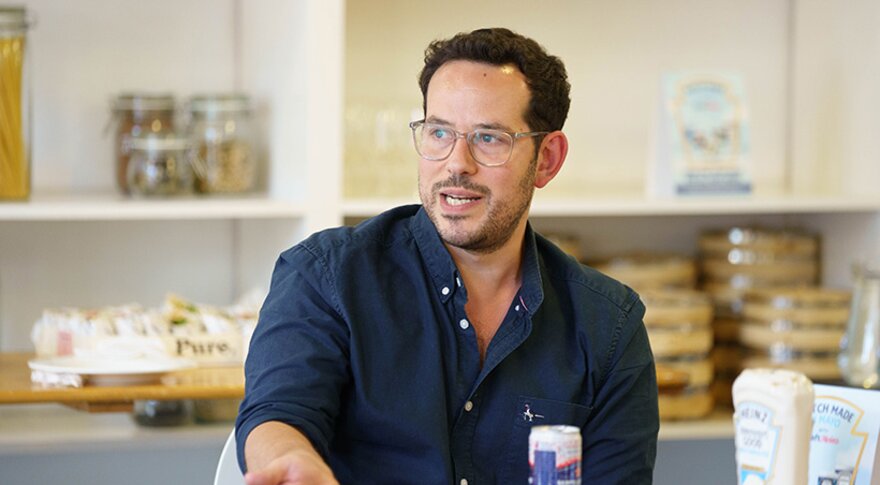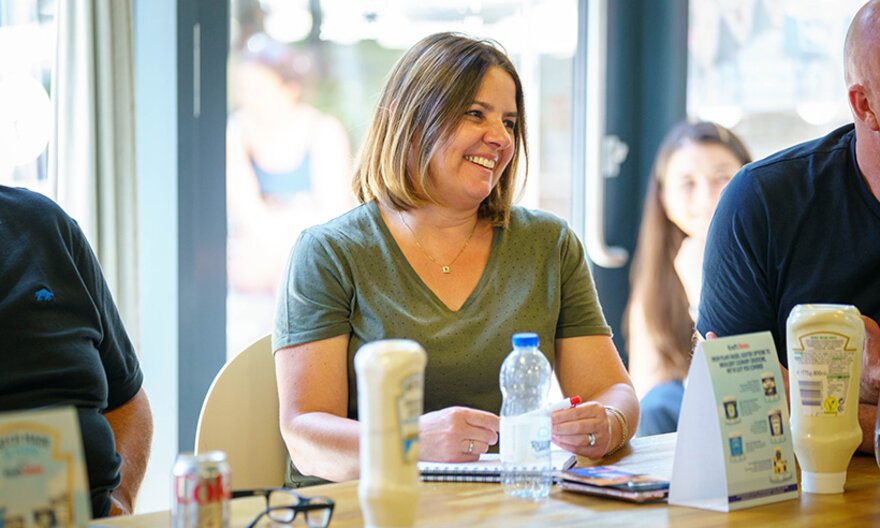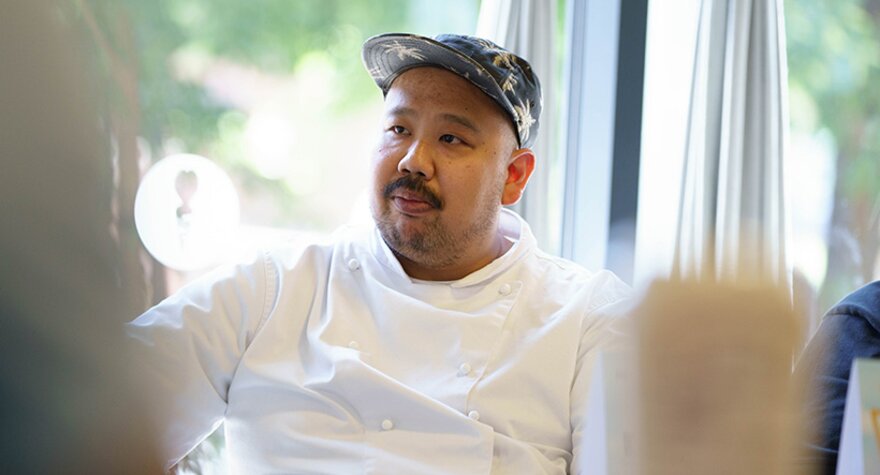More uses for mighty mayo
In association with
Mayonnaise is more than a condiment – it's a versatile ingredient. Will Hawkes attends the Heinz Mayonnaise round table to hear how chefs use it
Could mayonnaise be the next big thing? In one sense, it's an odd thing to ask – this egg-based emulsion is close to ubiquitous around the western world and beyond, used as a condiment on sandwiches and hamburgers and as the base for a variety of hugely popular sauces – but it could well be true.
That's because there is one thing about mayonnaise that is new, or at least popularly misunderstood: its versatility. "I've always thought of it as a condiment," said Budgie Montoya, head chef and founder of London Filipino restaurant Sarap and street-food specialists Apoy. "But having used it [in a different way], I can see that it is an ingredient that we can do interesting things with it. That's a mindshift."
Montoya, a Heinz Mayonnaise ambassador, was speaking at a recent Table 57 roundtable event that explored the potential of this famous sauce, and in particular Heinz's versions, which include a vegan option. He joined 13 other chefs, including his fellow Heinz Mayonnaise ambassador Jesse Dunford Wood (chef-proprietor of Parlour, Six Portland Road and Harvest, all in London), at the event.
An energetic discussion was informed by new research from Censuswide, in which 1,003 adults who eat mayonnaise and regularly eat out were asked a series of questions, from how they consume it to what would nudge them to try something made with mayonnaise.
Most interesting, perhaps, were their views on vegan food. Five per cent of respondents identified as vegan or 100% plant-based, 20% were flexitarian with animal or animal-derived products being consumed one to three times a week, and 13% said more vegan or plant-based options would encourage them to order dishes that include mayonnaise.
For Dunford Wood, vegan mayonnaise was the most intriguing option, particularly in terms of its culinary potential. "I think the revolutionary product is vegan mayonnaise, because everyone can eat it," he said. "I like to use the term, ‘can we veganise it?' because if you can and you're not compromising on quality, you've got a broader audience for the dish." Ian Nottage, head of food development at Fresh Direct, agreed, highlighting the textural advantage of this non-egg option. "It tends to be lighter and less intrusive [than standard mayonnaise]," he said.
There's a health element, as Dunford Wood pointed out ("I'm definitely very aware of what I eat, and I'm eating lighter, cleaner and fresher: a vegan diet helps with that") but there is a danger in terms of messaging, he said. "You have to be careful how you frame it [on the menu] – some people are turned off by the word vegan."
Plenty of those around the table felt that vegan mayonnaise (which is made with no artificial colours, flavours or preservatives) had the potential to become the most popular option. Mark Rigby, culinary sales manager for Upfield, says the success of vegan mayonnaise will depend on quality and price. "As soon as the [vegan] product is as good as the standard one, and the price point is the same, that's when people will just start to switch over," he said.
A-mayo-zing
The shift towards veganism is just one trend in terms of people's food habits. Nottage believed the experience of Covid-19 lockdowns – when restaurants were closed, and customers were cooped up at home – has fundamentally changed people's expectations when they go out to eat. "Lots of people have learned how to cook, so you're not going to get away with knocking out a dodgy spag bol or carbonara anymore and charging £15 or £16 for it," he said. "Customers are looking for an experience they can't have at home."
This means operators need quality ingredients more than ever, as they make life easier at a time when kitchen talent is at a premium, according to Rigby. "There's a problem not just with chefs' skill levels, but also the physical number of chefs," he said. "From an ingredients perspective, you need to be bulletproof, for it to be consistent time and time again."
This is one of the strengths of mayonnaise, as Lawrence Ager, culinary sales manager at Kraft Heinz, pointed out. "The thing I really like about mayonnaise is its versatility in taking flavour," he said. "With this one product you've got a stable base, and there's a plethora of things you can do with it. It's stable; you know it's not going to go wrong."
Customers are well aware of how mayonnaise can be used as a base to which any number of different flavours can be added. They're particularly keen on garlic (44% would be interested in trying this when eating out), honey mustard (25%) and spicy chipotle (21%). A third of respondents said they were more likely to dine at a restaurant that offered unique or signature mayo sauces and dips, with one in 10 much more likely.
Using mayonnaise as an ingredient, though, is an idea that's not so well understood. Some 60% of respondents to the Censuswide survey said they tend to consume mayonnaise mostly in cold-food dishes such as sandwiches, wraps and salads, while almost half of all respondents like to consume mayo as a condiment. Only a quarter said they enjoy having mayonnaise within hot meals like seafood, casserole or roasts.
But that could soon change as part of the rapid evolution that catering is undergoing, according to John Feeney, culinary and innovation director Europe & Africa, Griffith Foods. "It's so interesting because when you consider staffing, consistency, costs, there are [dishes] that you will not [now] be making from scratch," he said. "And that's when these dishes start to evolve, and the importance of new ideas like this come into play."
World class
Mayonnaise's versatility makes it a potential ingredient in a variety of different cuisines. This is a trend that consumers are very open to; 67% of respondents would be willing to try more mayonnaise-based dishes that incorporate global flavours or taste trends, and 17% would be very willing. It's something that Montoya has experimented with. "I wanted to make a Filipino version of Marie Rose sauce," said Montoya. "So we used banana ketchup, which is the favourite condiment in the Philippines, and it was great – it was still Marie Rose sauce, but using something that's culturally appropriate to Filipino cuisine."
Mayonnaise can also be used for basting, as a replacement for butter. As Montoya pointed out, it's a great option in terms of reducing risk in a street-food setting, where you might have 10 different trucks run by cooks with varying levels of competence. "We've got a lot of basting butters and compounds we use, so we've been very interested to test mayonnaise for basting," he said. "One key factor is flare-ups. With straight fat [like butter] that's a problem."
Mayonnaise can be better than butter in some instances, too, according to Diane Camp, executive development chef at Sodexo. "I was watching an Instagram session and this guy was making toasted sandwiches," she said. "He was asked – what's your secret? And he says, ‘I use mayonnaise instead of butter', and you think… ‘Well, yeah'."
For all mayonnaise's versatility, it certainly appears that public understanding lags some way behind the professionals. As Montoya said, how you present something often has a decisive impact on how popular it proves to be.
"Sometimes quirky doesn't sell," he said. "I see that all the time with the wording we have to use with our food. A classic example was a sausage dish we did at Meatopia a couple of years ago. The first day we called it longganisa, and no-one wanted it, and the next day we called it Filipino sausage, rice cake and egg, and we were slammed!"
"You've got seconds for the consumer to get it," said Rigby. "If you go with something weird and wacky, it doesn't necessarily work." That might prove to be the case for another unexpected use of mayonnaise: ice-cream. "I can see the possibilities," said Montoya, "especially in terms of fat and eggs – although the mustard [in the vegan mayonnaise] might be an issue."
It's a fundamental shift in the perception of mayonnaise, one that reflects how food as a category is changing. "We're moving on from beige," said Feeney. "This is the foundation of change. You look at the forage-able ingredients, for example it's green garlic, wild garlic, black garlic, it's a big group."
For Dunford Wood, it's been a learning process, a process that is far from complete. The potential of mayonnaise is still yet to be fully explored, he believes. "It's been fascinating to explore what you can do with these products," he said. "I've been doing all sorts of weird things with mayonnaise – some of the [dishes we created] ended up quite successfully, and some of them went straight in the bin!
"Mayonnaise historically is not a cooking ingredient, and now it potentially is – and there's five million different things you can do with it."
Beyond butties: recipe ideas
We all know that mayonnaise goes well with leftovers and sandwiches, but what are some more adventurous ways of using it? Here are some ideas that came out of the Table 57 discussion.
Steak
A lot of people baste their steak with butter before it goes into a hot pan, but mayonnaise is even better. Because it's stable, according to Lawrence Ager, it drips into the meat rather than sitting on the outside and thanks to the protein in the egg, it also gets beautifully seared on the outside.
Macaroni cheese
Put mayonnaise, cheese and macaroni in a pan and bring it up to heat, and you'll end with a very special macaroni cheese. Because there's no flour-based roux – like in a traditional macaroni cheese – the ‘cheese pull' is better, there's no floury flavour, and it's really creamy.
Pizza
Traditionally, pizza is made with a tomato sauce, but an increasingly adventurous customer base is prepared to go further. How about mayonnaise? You can add whatever flavour you want to the mayonnaise – kimchi, for example – and, because it's heat stable, it will happily survive a very hot pizza oven.
Chicken Kiev
One of the experiments Dunford Wood carried out with mayonnaise was using it in place of butter in chicken Kiev, one of his signature dishes. "It was lovely," he said. Mayonnaise can also be used as a replacement for bechamel sauce.
Savoury granitas
Because it freezes so well, mayonnaise is a great base for a savoury granita, made with – for example – beetroot and goat's cheese, which can then be grated over the top of a dish.










